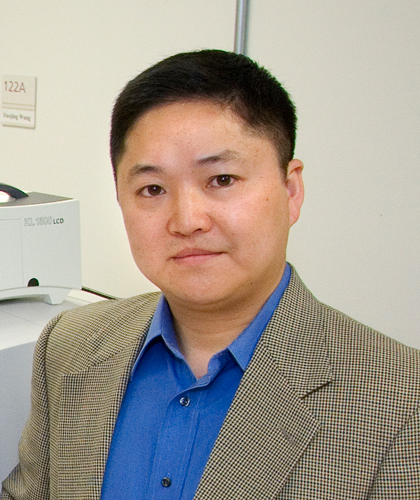“Multinozzle Arrays for Single Cell Metabolomics,” awarded to Daojing Wang
Developing new technologies for systems biology is a specialty of Daojing Wang, a principal investigator in the Life Sciences Division. The field of systems biology seeks to understand how the functions of a biological system emerge from the complex interactions of its many constituents.
Research in systems biology tends to organize itself around domains known as “omics,” for example genomics, an organism’s full set of DNA; proteomics, the full set of proteins encoded by the genome; or metabolomics, the full set of metabolites, such as hormones, in an organism or cell. An important feature of these sets is their complexity and heterogeneity among different cell types.
For proteomics, Wang and his colleagues, including Peidong Yang of the Materials Sciences Division, developed “microfabricated monolithic multinozzle emitters” – M3 emitters, for short – to enable mass spectrometry of biological fluids on the scale of a microprocessor “lab-on-a-chip.”
Wang’s LDRD Discovery project will develop a new technology, multinozzle arrays, to concentrate specifically on the metabolomics of individual stem cells.
“Single-cell analysis is the new frontier in ‘omics’ and represents a unique convergence of biology and technology,” says Wang. “Our previous work on M3 emitters for mass spectrometry laid a foundation for this new project.”
Wang says that single-cell omics – the global analysis of nucleic acids, proteins, and metabolites from a single cell – is poised to undergo unprecedented developments that could contribute significantly to stem cell research, cancer research, and bioenergy. The field is extremely challenging, however, and calls for what Wang, borrowing a popular business term, calls “disruptive technologies” – the kind of innovation, for example the digital camera, that completely overturns familiar ways of doing things.
The single-cell omics revolution is likely to arise from devices that work on the microscale or even the nanoscale, quickly analyzing the interactions of a myriad of components from which a cell’s functions arise and rapidly comparing those results with data from numerous other cells. Wang credits the “great facilities of Berkeley Lab’s Molecular Foundry and the Microfabrication Lab at UC Berkeley” for enabling potential breakthroughs in the fabrication and integration of micro/nano devices for single-cell analysis.
It’s the kind of technology that would carry a high payoff indeed. Anticipating contributions to the field through potential future support from the Department of Energy and National Institutes of Health down the road, Wang says, “This LDRD Discovery grant provides us a great opportunity to jump-start our efforts in the nascent field of single-cell omics.”
***
Read A Novel Route to Discovery, Part Five, last in the series, the search for industrial solutions to producing band-gap graphene structures with nanoscale resolution.
Additional information
A Novel Route to Discovery, Part One
A Novel Route to Discovery, Part Two
A Novel Route to Discovery, Part Three
Berkeley Lab’s Laboratory Directed Research and Development page
